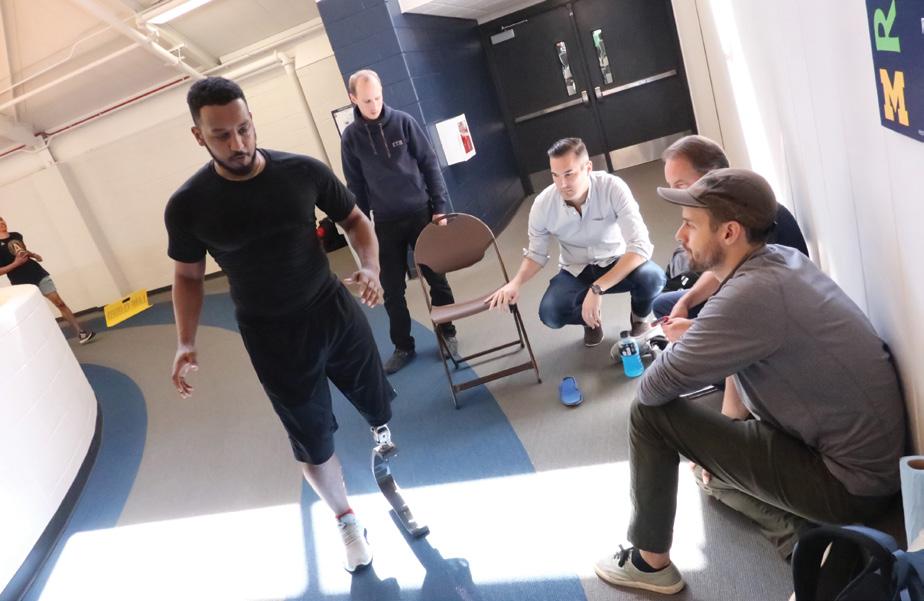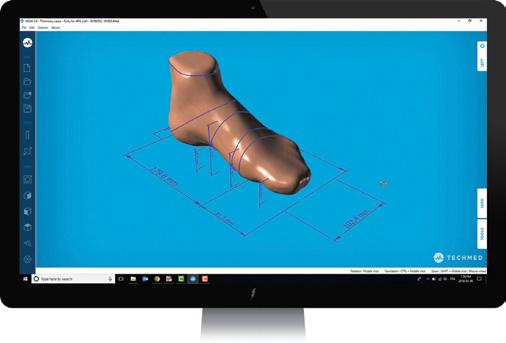
8 minute read
Member Spotlight
by AOPA
Collaborative Care in the Great Lakes State Orthotists and prosthetists work closely with other specialists at the University of Michigan’s O&P facility
THE UNIVERSITY of Michigan Medicine’s O&P Center is one of the largest single-site providers in the country—and one of the oldest, tracing its origins back to 1912. In the 1930s, the program was incorporated into the school’s Appliance Shop; a few decades later, orthotics and prosthetics were transferred from the university’s surgery department to the new Department of Physical Medicine and Rehabilitation. Michigan Medicine O&P sees more than 35,000 patients annually at its primary location and offsite clinics. The O&P Center and University Hospital Clinic are located in Ann Arbor. The Northville Health Center is a large multidisciplinary facility that offers orthotic, prosthetic, and pedorthic care, as is the Brighton Center for Specialty Care. In addition, the O&P Center offers multidisciplinary clinics for amputees and specialty clinics for brachial plexus, postpolio, and cancer care, enabling patients to see their physician as well as their O&P clinician in a collaborative environment. Seventy-three employees staff the O&P Center, including Medical Director Brian Kelly, DO, who oversees the entire program; Director of O&P Services Jeffrey Wensman, CPO; 33 clinical staff members; 10 technical staff; and 28 administrative/support personnel. The center provides customfabricated O&P services for all ages. Clinicians meet patients’ orthotic needs with cranial remolding helmets for babies, protective A patient tries out a new blade prosthesis.
FACILITY: Michigan Medicine O&P Center
LOCATION: Ann Arbor, Michigan
OWNER: University of Michigan
HISTORY: 108 years
face masks, and upper- and lower-limb orthoses. Prosthetic care is comprehensive, including upper- and lower-extremity devices fabricated by highly trained technicians who work side-byside with practitioners at the O&P Center. This care is further enhanced by strong relationships with university researchers who collaborate with the O&P Center to measure outcomes and develop new devices and treatments. Michigan Medicine O&P recently completed a renovation of its fabrication area, including technician work areas, storage, and a state-of-the-art dust collection system. “Our offsite facilities have the necessary tools and equipment to do all manner of fittings, repairs, and adjustments,” says Wensman.
The center’s marketing efforts focus primarily on the university’s own medical system. “One of our marketing goals is to make sure everyone who works for Michigan Medicine knows how to work with us,” says Kelly. As part of a university, the center has robust educational and training programs, including O&P educational courses for physical medicine and rehabilitation, orthopedic, and neurosurgery residents; clinical rotations for O&P students in technician and practitioner programs; and shadowing opportunities for interested high school and college students. The center conducts extensive outreach activities through the University of Michigan Community Amputee Network, or UCAN. A six-week class called Amputees Creating a New Tomorrow delivers information on such topics as phantom pain, driving, body image, and physical therapy. Another UCAN program features a monthly support group, a monthly newsletter, and a website with links to services and activities such as ballroom dance, sporting activities, and social outings for individuals with limb loss. Patients also may choose to take part in peer mentoring and online support groups. Beyond its vast range of offerings, what makes the O&P Center unique is its teamwork and coordination of care between its physicians and practitioners, says Kelly. “A patient might have trouble fitting into their socket because of an undiagnosed medical condition, such as congestive heart failure leading to swelling in the limbs. Another patient may be experiencing more frequent falls from advanced diabetes and not related to the alignment of the prosthetic device,” he explains. “We see each person as a whole, in all of their medical aspects, and we have access to physician specialists for every situation.” “Michigan’s mantra is ‘the team, the team, the team,’” adds Wensman. “We have to work together to make this work.”
Deborah Conn is a contributing writer to O&P Almanac. Reach her at deborahconn@verizon.net.
An O&P Star is Born
The only nationwide insurance company that supports the O&P industry.
★ WIN FOR THE PAST Cailor Fleming’s legacy to the O&P industry has helped reduce premiums nationwide, with companies paying a fraction of insurance liability costs as they were a decade ago.
★ WIN FOR THE PRESENT Best price for everyone! Cailor Fleming is partnered with AOPA to support the profession, provide the best insurance protection, best insurance value and best insurance service to all orthotic, prosthetic and pedorthic patient care facilities and suppliers.

★ WIN FOR THE FUTURE Join Cailor Fleming and support AOPA’s O&P legislation lobbying efforts at state and federal level. Each company that joins, allows us to strengthen our support for the O&P industry—fi ghting for your interests and protecting your O&P business. Royalty payments Cailor Fleming makes to AOPA based on their premium revenue helps make sure AOPA has the resources it needs to hire the most talented lobbying team, conduct comparative effectiveness research and offer our wide range of services to members.
Requesting a quote from Cailor Fleming is a win—one win for you in service, price and coverage and another win for you through a stronger AOPA.
REQUEST A FREE INSURANCE QUOTE TODAY AND JOIN FORCES WITH CAILOR FLEMING AND AOPA
An ENDORSED MEMBER of AOPAAn ENDORSED MEMBER
Also endorsed by
www.bocusa.org


Scanning Solutions
Canadian company offers human body measurement software to assist in fabricating O&P devices
TRUE TO THE STARTUP mythos, Michel Babin developed the software at the heart of his company in his basement. In 2007, Babin was working at Creaform 3D, a company that produces 3D scanners for a variety of industries. He realized that the scanners were not very user-friendly and required a high learning curve, leading to often inconsistent results.
His solution was to develop software designed to simplify the process and to produce more usable information. Targeting the O&P industry, Babin created MSoft to more easily integrate scans of the human body with computeraided tools to fabricate devices. Babin founded TechMed 3D in 2009 and made his first sale a few months later. In 2010, he hired his first employee. Today, the company has 20 employees, plus customers in more than 50 countries, including orthotists, prosthetists, and central fabrication facilities.
“The scanner produces raw data,” he explains. “It doesn’t address alignment, and it’s not that easy to turn that data into useful information for fabricating devices. Our software provides alignment, reduces noise around the file, fills in the holes, and produces a representative file of the body part that is compatible with construction and modification.” According to Babin, the software is “scanner agnostic,” so the choice of scanner is left to each facility, but TechMed 3D does offer two types of scanners for purchase. The BodyScan scanner is produced by Creaform 3D. “It The TechMed 3D team

COMPANY: TechMed 3D
OWNER: Michel Babin
LOCATION: Quebec City, Quebec
HISTORY: 11 years

is designed to scan the human body,” says Babin, “and it tolerates micromovements, which makes it possible to scan babies’ heads for orthotic helmets even if they move and to scan a torso even while the subject is breathing.” The Structure Sensor Mark II, produced by Occipital, is an economical option that turns an iPhone or iPad into a 3D scanner. The product is small and lightweight, so it is helpful for situations that require a portable scanner. It works with TechMed’s 3DsizeME app for Apple devices, which controls and optimizes the scanner. In 2012, TechMed entered a partnership with Rodin 4D, a major presence in the O&P industry,
which integrated MSoft into its system. In 2019, the company developed MSoft+, which automates certain algorithms and is able to generate a complete 3D file, recommend products, and provide measurements within 30 seconds. MSoft with measurements obtained from a scanned foot
The company also has developed a new business model, called Pay per Scan, in which the software, support, and updates are free, with fees incurred only when the file is used. Using this model, “customers do not have to finance the purchase of the software,” explains Babin, “which is a big help for their cash flow management.” TechMed is unique, says Babin. “A few scanner companies can provide software for day-to-day O&P work, but it’s expensive and not that intuitive. Our real competitors are traditional methods of fabrication, like plaster casts and foam boxes.” The software is intuitive enough that clinicians can master it by watching brief videos, according to Babin. “We offer a lot of one- and two-minute videos, which can be very helpful when people decide to move from plaster to digital.” TechMed markets its products through trade shows, its website, and in-person customer visits. The company blog both introduces new products and highlights other technologies and developments in the O&P industry. As it establishes itself, TechMed is exploring ways to give back to the community at large; Babin has been in discussions with Doctors Without Borders to donate software.
Babin expects more companies to move from plaster to digitization, both for environmental reasons and for improved efficiency and accuracy. “Clinicians will outsource production or do their own in-house, adopting whatever business model best serves them,” he says. “Our goal is to continue to provide a cheaper, faster, and easier solution to that process.”
Deborah Conn is a contributing writer to O&P Almanac. Reach her at deborahconn@verizon.net.










